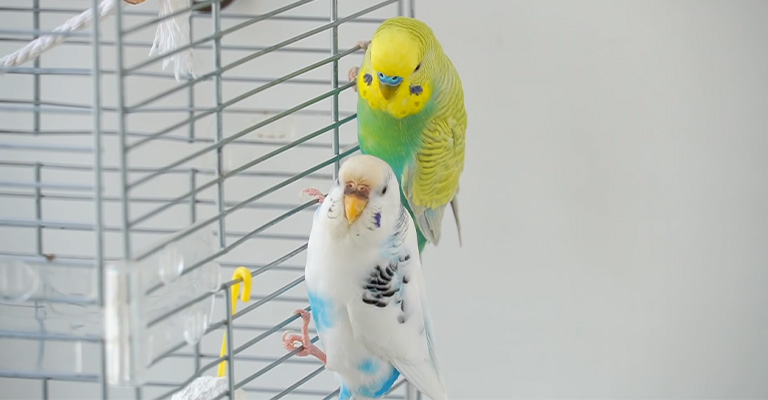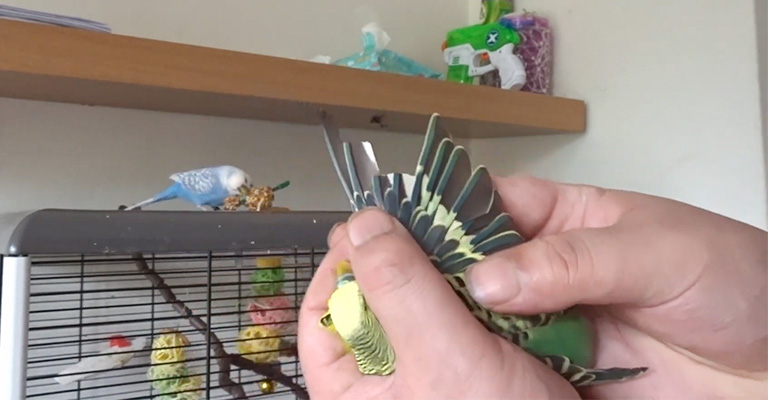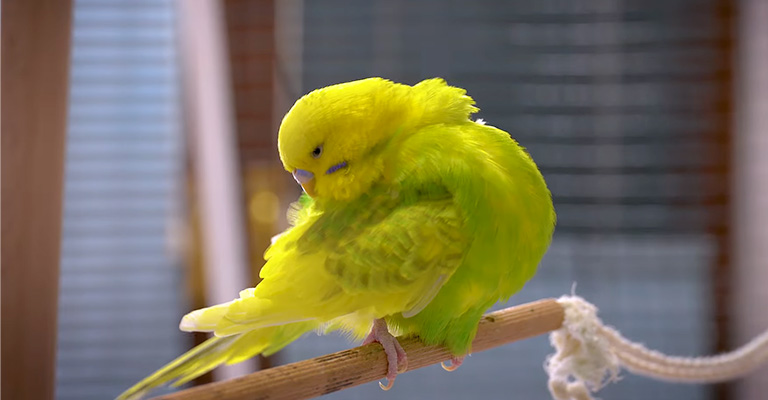Have you ever noticed your beloved budgie lifting one wing, seemingly without any apparent reason? As a budgie owner, it’s natural to be concerned when you observe unusual behavior in your feathered friend.
One such behavior that often raises questions is when a budgie lifts one wing while perched or in flight. But fear not, for we are here to shed light on this peculiar phenomenon.
In this article, we will delve into the commonly asked question: Why is my budgie lifting one wing. Budgies, also known as parakeets, are intelligent and social birds, and their actions can often be indicative of their physical or emotional well-being.
We will explore both medical and behavioral factors that could contribute to this behavior, including potential injuries, pain, discomfort, stress, or even mimicry.
Understanding the underlying causes of your budgie’s one-wing lifting can help you provide the necessary care and support to ensure their health and happiness.

Why Is My Budgie Lifting One Wing?
When it comes to observing the behavior of your budgie, any sudden changes can raise concerns for their health and well-being.
One such behavior that might catch your attention is when your budgie lifts one wing.
This action, although seemingly unusual, can have a variety of reasons behind it. It’s important to carefully consider the context and other accompanying behaviors to determine the cause.
Here are the possible reasons for budgie lifting one wing:
Stretching
Budgies often engage in stretching exercises to keep their muscles flexible and alleviate any discomfort. The action of lifting one wing could be a simple stretching routine to maintain the wing muscles.
Cooling Down
Birds don’t sweat like humans; they regulate their body temperature through their respiratory system. Lifting a wing allows air to circulate through the feathers, helping them cool down on warmer days.
Molting
During the molting process, budgies shed old feathers and grow new ones. This can be uncomfortable, and lifting one wing might indicate an attempt to alleviate any discomfort caused by the new feather growth.
Injury or Pain
Budgies are agile, but accidents can happen. If your budgie has injured one of its wings, it might hold it in a lifted position to avoid putting pressure on the injured area. Similarly, if there’s pain in the wing, holding it up could be a way to find relief.
Behavioral or Mimicking Reasons
Sometimes, budgies can exhibit quirky behaviors simply because they are mimicking something they’ve seen or heard. If they’ve seen other birds lifting their wings or if you’ve been demonstrating the action, they might copy it out of curiosity.
Communication

Budgies communicate through body language, and lifting a wing could be a way to signal something to other birds in the vicinity or even to you. It might be a sign of distress, attention-seeking behavior, or an attempt to establish dominance.
Nesting Behavior
In some cases, lifting one wing might be connected to nesting behavior. If your budgie is paired with another, it could be part of a courtship display or a way to show off its health and vitality.
Respiratory Issues
While less common, respiratory problems can cause discomfort for budgies. Lifting a wing might be an attempt to make breathing easier if there’s any congestion or irritation in the respiratory system.
How Do I Know Why Is My Budgie Lifting One Wing?

To determine why your budgie is lifting one wing, you’ll need to carefully observe its behavior and consider various factors. Here are steps you can take to understand the reason behind this behavior:
Observe Regularly
Pay close attention to your budgie’s actions over a period of time. Note if the wing-lifting behavior is happening consistently or intermittently.
Context
Consider the context in which the behavior occurs. Is your budgie alone or interacting with other birds? Is it engaged in a specific activity, such as preening, eating, or resting?
Accompanying Behaviors
Take note of any other behaviors that accompany the wing-lifting. Is your budgie displaying signs of distress, vocalizing differently, or behaving unusually in other ways?
Temperature
Assess the temperature of the environment. Budgies may lift their wings to cool down in warmer temperatures.
Physical Examination
Gently examine your budgie’s body for any visible signs of injury, discomfort, or changes. Check for any swelling, redness, or unusual lumps around the wing area.
Feather Appearance
Inspect the feathers on the lifted wing for any abnormalities, such as broken or bent feathers, which could indicate an injury.
Respiratory Signs
Watch for any signs of respiratory distress, such as labored breathing, wheezing, or nasal discharge. Respiratory issues could cause discomfort and lead to wing-lifting.
Interaction with Other Birds
If you have multiple budgies, observe how the one lifting its wing interacts with others. Is it being avoided by other birds, or is it engaging in dominance displays?
Recent Changes
Consider if there have been any recent changes in the budgie’s environment, diet, or routine that could be contributing to the behavior.
Consult an Avian Veterinarian
If the behavior continues or if you notice any signs of distress, pain, or other health issues, it’s best to consult an avian veterinarian.
A professional can perform a thorough examination and provide a more accurate diagnosis.
Remember that budgies can display complex behaviors influenced by a variety of factors. Close observation and professional advice will help you determine whether wing-lifting is a natural behavior or a sign of an underlying health concern.
What to Do If My Budgie Is Lifting One Wing?

If you notice your budgie lifting one wing, it’s important to take steps to ensure its well-being. Here’s what you can do:
Observe Carefully
Pay close attention to your budgie’s behavior and monitor how often it lifts its wing. Note any other unusual behaviors or signs of distress.
Examine for Injuries
Gently handle your budgie to examine the wing and surrounding area for any visible injuries, swelling, or abnormalities. Be cautious and gentle while doing this to avoid causing additional stress.
Check Feather Condition
Inspect the feathers on the lifted wing for any signs of damage, such as broken or bent feathers. This could indicate a feather-related issue.
Assess Environment
Ensure that the temperature in your budgie’s environment is appropriate. If it’s too warm, provide ways for your budgie to cool down, such as placing a shallow dish of water in its cage or using a fan on low.
Isolate if Necessary
If you have multiple budgies and notice that the one lifting its wing is being bullied or excluded by others, consider providing a separate space temporarily. This can prevent further stress.
Consult an Avian Veterinarian
If the behavior continues or if you notice any signs of distress, pain, or changes in appetite or activity levels, it’s recommended to consult an avian veterinarian.
A professional can perform a thorough examination to determine the underlying cause and recommend appropriate treatment.
Maintain a Balanced Diet
Ensure your budgie is receiving a well-balanced diet that includes a variety of seeds, pellets, fresh vegetables, and occasional fruits. Proper nutrition supports overall health and immune function.
Provide Mental Stimulation
Budgies are intelligent and social birds. Offer toys, perches, and activities that engage their mind and body. This can help alleviate boredom and stress.
Minimize Stress
Reduce any sources of stress in your budgie’s environment. Loud noises, sudden movements, and changes in routine can all contribute to stress.
Regular Vet Check-ups
Even if your budgie’s behavior appears to return to normal, consider scheduling regular check-ups with an avian veterinarian to ensure its long-term health.
Budgies are delicate creatures, and their behaviors can be indicators of various conditions. It’s always better to be cautious and seek professional advice if you’re concerned about your budgie’s health or behavior.
FAQs
Budgies might pull out their feathers due to various reasons, including stress, boredom, hormonal changes, skin conditions, parasites, or an improper diet.
If your budgie is engaging in excessive feather plucking, it’s essential to consult a veterinarian to determine the underlying cause.
To prevent boredom, provide your budgie with a variety of toys, perches, and activities that stimulate its mind and physical abilities.
Rotate toys regularly to keep things interesting, and consider placing a mirror or a companion budgie (if it gets along with others) to alleviate loneliness.
Budgies are social birds and thrive on companionship. While they can be kept alone, they often do better with a companion budgie.
If you choose to keep a single budgie, be prepared to spend more time interacting with it to provide the social interaction it needs.
Taming a budgie requires patience and gradual steps. Start by spending time near the cage, speaking softly to the bird.
Once it’s comfortable with your presence, offer treats through the cage bars. Then, work on getting the budgie used to your hand by placing your hand in the cage without grabbing it.
A balanced diet for budgies includes a combination of high-quality budgie seed mix, pellets, fresh vegetables, and occasional fruits. Offer a variety of foods to ensure proper nutrition.
Avoid feeding them avocado, chocolate, caffeine, and foods high in salt and sugar.
Final Words
Observing your budgie lifting one wing can be a puzzling experience, but it’s important not to panic. By being attentive and understanding the potential reasons behind this behavior, you can take appropriate steps to address any underlying issues.
Remember, if you suspect your budgie is in pain or discomfort, it’s always best to consult with an avian veterinarian. They can provide a thorough examination and offer professional advice tailored to your budgie’s specific needs.
Additionally, creating a stimulating and enriching environment for your budgie, along with providing a balanced diet and regular exercise, can contribute to their overall well-being and reduce stress levels.
By being a caring and observant budgie owner, you can ensure that your feathered friend leads a happy and healthy life.
So, embrace the journey of understanding your budgie’s unique behaviors, and enjoy the special bond you share with your delightful avian companion.